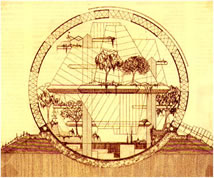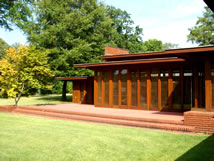There’s No Place Like Home |
Home Ownership in the 21st Century
a study in UpSideDown economics
a FutureViews™ Exercise
|
Housing in the United States today is the Parable of the Tractor [future link] writ large and gone mad. It also is the tragic story of what happens when people anywhere, anytime out-source a basic competency of life - in this case the act of making shelter. The average person today, in the “advanced” societies, is trapped in a system which has little regard for his/her interests except as those of a willing consumer who can be convinced they have invented needs. About 75 percent of the cost of a house today is for fees, services and profits not for the actual materials and labor necessary to build it. These are the services you pay for to get what you do not know how to do or do not want to do yourself. Add to this the ubiquitous mortgage made necessary because the house is not affordable and the real cost of ownership, if one were to stay someplace for 30 years, makes the actual labor and material cost of the building shrink to insignificance. Of course few do stay somewhere and pay off a mortgage (translate: death-gage). They are seduced to become a consumer, the home a commodity and “investment,” in a market that can only be compared to gambling, the last person holding the bag is the sucker in this highly institutionalized shell game. People do not own - they become wage slaves who rent. Remarkably, all this is packaged and sold as “The American Dream.” A dream it is and often the dream turns to nightmare when the time comes to fleece the over extended public and take back the inventory. Who profits. Well, follow the money which means the multiple transactions which have become the ebb and flow life cycle of houses and subdivisions. Who benefits? The average home owner? I think not.
|
| It might be argued that all of this is “worth it” given that the house delivered is truly modern, sustainable, up gradable, comfortable, efficient and a work of true art. This can hardly be the case argued by any reasonable standard of engineering, building resource usage or art. The standard that dominates the typical home in the US, and a great part of the “advanced” world is resale value determined by the keepers of the market who happen to be the ones acquiring all the money from the many transactions required by the labyrinthine system which produces the houses. I refuse to use the term “making” money. This once honorable concept implied that significant value added justified the fees and profits. I am reminded of once going down the Rhine River in Germany and commenting on the beautiful castles constructed on its banks. I was told that they were about a days journey apart and each one had a Lord who imposed a tariff on the goods as they traveled to the sea. One wonders how much was left at the end. Just enough I presume to get people coming back to try it again. This describes the process of getting a home. What you end up with is a tiny real value and you only choice is to treat it as a commodity and trade and trade hoping you are not the one holding the bag at one of the periodic “ends” of the game. Or, you can stay where you are pay the tariff for 30 years and finally call yourself an owner. Even the banks and mortgage companies won’t love you as they do so much better rolling the paper - at least until recently. The very rich, of course and overwhelm the system with money and get what they want that is if by the time they have this much money that can socially afford to break the mold and live in a real piece of architecture. Most often they end up in the same thing as every one has only bigger and more expensive with much better materials covering the same pathetic structure underneath. Sometimes even those annoying, noisy little fans in the bathrooms make it to the big time. |
| Sadly, it is all veneer. Veneer culture, borrowed designs, hyped location, impressive features - that is features to impress - with little that is authentic to narture and authentic to life. |
| If you think that I am saying that everyone involved in producing a house is a crook or a fool I am not. Sure, some are crooks, some are merely exploiting the situation - yet many Developers, architects, contractors, subcontractors, craftspersons, suppliers and manufactures are trying their best while working in an insane system no one - other than a crook and a fool - would design from scratch. Look at the recent melt down in the housing and you will see that the negative consequences are equally shared by almost everyone in the end. Unfortunately, it will be treated as a financial problem - which is is but only in part - and the underlying root cause: the philosophy and practice of the system, and the product which is produced, will be ignored. It is in the major area, ignored as it is, that the problem lies. It is the overly expensive product that requires the extreme financing in the first place. The houses offered are bloated, two large and poorly build by an inefficient process. They do not address real contemporary requirements. They are commodities not homes - and they are treated as such. |
| If you want a healthy home, do your self a favor and refuse to play the game. Get out of the system, learn what you need to know, find a few passionate, competent people and BUILD. If your situation is such that building is really not an option - please do not assume that it is not - they buy a real well designed and crafted house and modify it to fit your own life-style and esthetic sensibilities. Above all, do not get caught in the financing game. Start small with a high quality building and expand as you can with cash. Dom’s do anything for an abstract “market” which does not in fact exist - build for yourself. Commit to a building so that it can provide authentic shelter for you. This article lays out the first steps to get you started on this path. |
| The financial ins and outs of this social tragedy we call the American dream - itself a fabrication of advertising - constitue the focus of this writing. If you think the state of modern housing is fine, then the rest of this piece is not likely to attract you. If not - if you are interested in taking back the practice of shelter, then read on. To under stand the economics of the American house, it is necessary to decompose all the steps which house creation and use goes through over the period of a generation. It is necessary to understand the various roles played by the architect, developer, real estate agent, contractor, sub contractors, craft persons, manufactures, real estate broker and the army of services that follow after the house is built and sold. This army of specialists creates a great complexity which itself generates the need for more specialization It is necessary to understand the intrinsic economics of the basic idea of a house and the theory and method of how it is built. It is necessary to understand utility and size, location and transportation, neighborhood and community. Most of all, the larger economy-ecology has to be addressed and to understand what are the consequences of being a consumer in a consumer economy. Gathering this knowledge allows you to understand the true cost of each of the many decisions you will make as you create and procure your shelter. You can relate these costs to the portion of Right Livelihood they return you. By gaining basic competency in the science, art and craft of shelter-making means you can take responsibility for this basic human requirement and determine how you can secure the right environment for you. For you, not some statistic that does not breathe and act; that really does not exist. In this quest, it is important to know the difference between pixels and molecules. For a house is a physical thing that should have a soul. It is one of the most important creative acts you will take... |
| To do all of this, you will have to challenge a lifetime of programming. This is not easy. It requires digging deeper and deeper into your beliefs and values. This is worth doing in itself. It is necessary in order to free your mind and discipline it for the task of building a work of art that you can live in. To actually build a house requires a number of trade skills. To conceive of one that is an expression of you, and to make it real requires a range of mental skills necessary for efficacy in many other realms as well. The subject of shelter, itself cannot be divorced, as it seems to be today, from all the core competencies of life: shelter, food, learning, mental and physical health, productive work, mating, reproduction defense, celebration, play, social intercourse and understanding WHY. All of these are intertwined; none can be given up to others; all require collaboration; and all are expressed in the HOME. The creed of (over) specialization puts the sovereignty of the individual and society at mutual risk. Life cannot be out sourced. It can and must be built by the collaboration of free individuals. Today this freedom is being lost. The inability of a family to secure efficient, artistic and sustainable shelter is but one example of this loss of sovereignty - it is a primary example. |
| It is one thing to trade unique and specialized skills for mutual profit. It is entirely something else to become so removed from the requirements of life that you cannot even be a competent buyer or steward of that which you have purchased. You may have earned the money, and the simple skills to make the trade, yet not sufficient knowledge of the thing in question. It is from this kind of detachment and ignorance that major social ills and evils spring. The design and making of something is not separate from its use. All actions are part of an interdependent social and physical ecology. Responsibility cannot be fluffed off. Consequences can be ignored for a time yet they will ultimately play out. Go back are read the newspapers of 2008. Is there no connection between all of the accumulating crises that dominate the press? |
|
| Some example may serve to illustrate the concepts stated above. Today, we have many people who are losing their houses, transportation costs are making it difficult for extensive commutting. Food cost costs are sky rocketing and the quality of food for many is highly suspect. Children are increasingly being drugged to better fit into the social regime. Energy costs are climbing. Community is almost non existent. We have incredible manufacturing capability particularity in communications and computing. Our problems are seen as political which they are in part. With all this suffering you would think that people would begin to challenge the basic design of our architecture . Yet these dialogs are not taking place. Consider Domicile which I designed 40 years ago: |
 |
| Domiciles can provide double the standard of living at half the cost. It is a working and living environment that provides its community with a number of transport, tooling, food and lifestyle choices supporting a variety of economic options. Click on the drawing for project description. |
|
| Am I saying that Domicile will solve all of these problems? No. It is a viable option for a number of people depending on their personalities and life-style goals, And, the principles behind the design have wide applicability. What is important with the Domicile concepts are two design assumptions: First, that there is massive redundancy of basic amenities and tooling which are under utilized by most owners; second, that the complexity and inherent expense of our real estate, transportation, food supply system is not affordable by a significant number of our population and that these costs can be greatly reduced with a different design strategy expressed in a number of small easy to build projects. Domiciles can be organized around affinity groups which provide the support of an extended family. Would this be a better option for a young couple than an apartment of a standard “starter” single family home? I think so when you look at what they have to deal with and the cost they pay for what they get. The solution to housing is not to be found just in the design of projects - although, as we will see, there are significant saving to be had in this realm - it is also to be found the the very philosophy and concept of what is a home and what is a sustainable-viable way of living. |
| Domicile - and please, do not confuse it with an apartment building - is only one strategy, there are many others. Of the several I will outline here, you may find a fit or not. For any individual or family each strategy may have attractive and not attractive aspects. They may suggest a combination of approaches or a totally new idea. Hopefully, they will offer an alternative to the ONE strategy - with all its pretensions of choice - which dominates the market today. In the craft of architecture, what we are talking about is the PROGRAM Statement. A thoughtful and innovative, Program Statement which has to be developed for each individual in each project, is a major missing element in the process of making homes; instead, housing is based on habit, averages, superficial styles and the offering of fake “options.” Domicile offers capital and ongoing cost savings by two principle design strategies: 1) scale using an efficient enclosing envelop with al of the actual living spaces free of weather considerations, and, 2) The sharing of community resources cutting down on redundancy of investment and building on both external and internal economies [links: capitalism for the rest of us - build your own community]. Frank Lloyd Wright addressed these issues with his Usonian House which he designed for the average income family. This experience was based on many prior efforts of his with what today we would call affordable housing [link: rediscovering wright project]. He also design several Usonian Communities as well as taking the idea to the small city scale called Broadacre City. |
 |
| The Rosenbaum house as it looks today nearly 70 years after it was built for a young couple. It was expanded for a growing family in 1940. Usonians remain an unique American Architecture and proof that an average income can affort great archtecture. Photo © 2008 Lisa Piazza. |
|
| 72 years ago, Frank Lloyd Wright built his first Usonian home [link: return of the usonain]. Building an affordable home for the average family was a quest of his which occupied him throughout his career. With his Usonian designs he put together a half a century of experience, considerable genius and a keen sense of how to integrate the entire design-build process given the conditions of the time and the tools which he had in hand. The are many aspects of the Usonian which I illustrate elsewhere [future link] what I want to focus on here is the design strategy of build a small high quality house which can be expanded in the future as a family’s needs require it. Two prime examples of this are the Hanna and Rosenbaum early Usonian houses built in the late 1930s. There are several things about the Wright Usonian house relevant to our topic: they were small houses built with simple materials yet are great works of architectural art; they were designed to grow with the family through the family life cycle from young couple, growing children, and then becoming a gracious home for mature “empty-nesters;” They were designed to encourage interaction among the family members yet provide small personal places of individual refuge; they embraced nature; many Usonian were contracted, and several actually successfully built, by the owners. These houses were built all over the U.S. and remain highly regarded even though, or maybe because, they represent a distinctly different way-of-living than has become the ubiquitous American consumer life-style. There have been many books written about families who build and lived in these homes including the reflections of the children who grew up in them [link: postusonian reading]. |
| The principles [link: what makes an usonian an usonian] behind the Usonian House are as valid today as in Wright’s time. The architectural grammar and the way they are built has to change to meet contemporary conditions. To create an affordable, sustainable, livable work of art that a working family can acquire without great risk and sacrifice is the goal of the postUsonian Project [link: postusonian intent]. |
|
Matt
Taylor
Nashvillle
May 3, 2008

SolutionBox
voice of this document:
ENGINEER • STRATEGY • CONSTRUCTION DOCUMENT
|
click on graphic for explanation of SolutionBox |
posted:
May 3, 2008
revised:
August 5, 2008
• 20080503.708910.mt • 20080714.680022.mt •
* 20080730.000011.mt • 20080803.777888.mt •
• 20080805.000001.mt •
(note:
this document is about 10% finished)
Matt
Taylor 615 720 7390
me@matttaylor.com
Copyright©
Matt Taylor 2008
aspects
of this material is
patented and in patent pending |
|
|
|